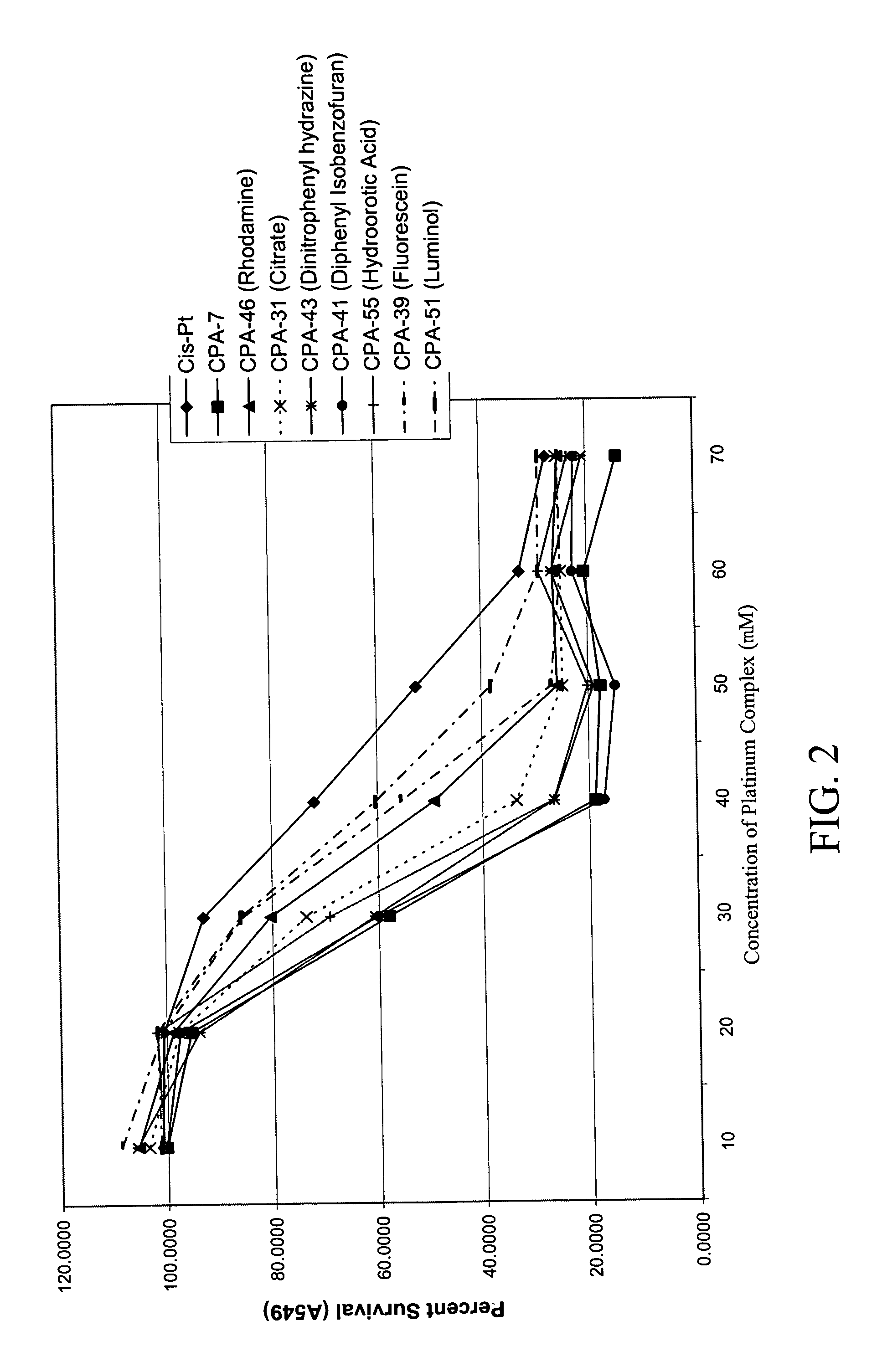Platinum complexes and methods of use
a technology of complexes and complexes, applied in the field of platinum complexes and methods of use, can solve the problems of complex-based therapy on cellular signaling and the therapeutic importance of such interactions that have yet to be explored
- Summary
- Abstract
- Description
- Claims
- Application Information
AI Technical Summary
Benefits of technology
Problems solved by technology
Method used
Image
Examples
example 1
MTT Assay Data for Platinum Complexes
[0108]MTT assays are used for the quantitative determination of cellular proliferation and activation and for the quantitation of in vitro tumor cell sensitivity to anti-cancer compounds. The assay is based on the cleavage of the yellow tetrazolium salt MTT into purple colored formazan by metabolically active cells. Solubilized formazan product can be photometrically quantitated using an ELISA plate reader. A decrease in the number of living cells results in a decrease in total metabolic activity which leads to a decrease in color formation. Platinum complexes of the present invention were tested in MTT assays using A549 cells to determine anti-cancer cell activity. The results are shown in Tables 1, 2, 3, and 4 and FIGS. 1, 2 and 4. Table 1 shows percent survival of A549 cells and Table 2 shows the IC50 from the data in Table 1. FIGS. 1, 2, and 4 show percent survival versus platinum complex concentration in graphical form. FIG. 6 shows a graph ...
example 2
XTT Assay Data for Platinum Complexes
[0114]The XTT assay is based on the conversion of the yellow tetrazalium salt XTT into an orange formazan dye by metabolically active cells. The orange formazan dye is soluble and can be photometrically quantitated using an ELISA plate reader. A decrease in the number of living cells results in a decrease in total metabolic activity which leads to a decrease in color formation. Platinum complexes of the present invention were tested in XTT assays using A549 cells to determine anti-cancer cell activity. The percent survival of cells versus platinum complex concentration is shown in graphical form in FIGS. 3 and 7.
example 3
Reduction of CPA-7 Platinum Complex by Glutathione
[0115]FIGS. 5A-C show the inertness of CPA-7 to glutathione reduction. In the figures, 20 μm CPA-7 was added in PBS / 20% DMSO with 10 mM glutathione. The readings were initiated in late evening where data points were collected every 10 minutes at the lambda max for CPA-7, 226 nm. The data shows slow reduction which then virtually stops during the night hours, and resumes the next day. This data demonstrates sensitivity to light and stability against GSH reduction. Data was collected on a Varian Cary 50 fitted with a fibreoptic probe in the kinetics mode. The Cary 50 uses a pulsed Xenon lamp with discontinuous irradiation between readings. A 25-mL volumetric flask was used for the solution with a magnetic stirring bar at slow speed.
PUM
 Login to View More
Login to View More Abstract
Description
Claims
Application Information
 Login to View More
Login to View More - R&D
- Intellectual Property
- Life Sciences
- Materials
- Tech Scout
- Unparalleled Data Quality
- Higher Quality Content
- 60% Fewer Hallucinations
Browse by: Latest US Patents, China's latest patents, Technical Efficacy Thesaurus, Application Domain, Technology Topic, Popular Technical Reports.
© 2025 PatSnap. All rights reserved.Legal|Privacy policy|Modern Slavery Act Transparency Statement|Sitemap|About US| Contact US: help@patsnap.com



